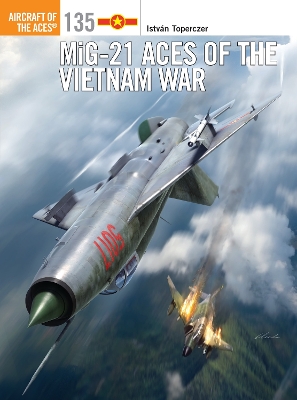Aircraft of the Aces
2 primary works
Book 130
At the beginning of the Vietnam War, the Vietnam People's Air Force (VPAF) were equipped with slow, old Korean War generation fighters - a combination of MiG-17s and MiG-19s - types that should have offered little opposition to the cutting-edge fighter-bombers such as the F-4 Phantom II, F-105 Thunderchief and the F-8 Crusader. Yet when the USAF and US Navy unleashed their aircraft on North Vietnam in 1965 the inexperienced pilots of the VPAF were able to shatter the illusion of US air superiority.
Taking advantage of their jet's unequalled low-speed maneuverability, small size and powerful cannon armament they were able to take the fight to their missile-guided opponents, with a number of Vietnamese pilots racking up ace scores. Packed with information previously unavailable in the west and only recently released from archives in Vietnam, this is the first major analysis of the exploits of Vietnamese pilots in the David and Goliath contest with the US over the skies of Vietnam.
Taking advantage of their jet's unequalled low-speed maneuverability, small size and powerful cannon armament they were able to take the fight to their missile-guided opponents, with a number of Vietnamese pilots racking up ace scores. Packed with information previously unavailable in the west and only recently released from archives in Vietnam, this is the first major analysis of the exploits of Vietnamese pilots in the David and Goliath contest with the US over the skies of Vietnam.
Book 135
Having learned their trade on the subsonic MiG-17, pilots of the Vietnamese People's Air Force (VPAF) received their first examples of the legendary MiG-21 supersonic fighter in 1966. Soon thrown into combat over North Vietnam, the guided-missile equipped MiG-21 proved a deadly opponent for the US Air Force, US Navy and US Marine Corps crews striking at targets deep in communist territory.
Although the communist pilots initially struggled to come to terms with the fighter's air-search radar and weapons systems, the ceaseless cycle of combat operations quickly honed their skills. Indeed, by the time the last US aircraft (a B-52) was claimed by the VPAF on 28 December 1972, no fewer than 13 pilots had become aces flying the MiG-21. Fully illustrated with wartime photographs and detailed colour artwork plates, and including enthralling combat reports, this book examines the many variants of the MiG-21 that fought in the conflict, the schemes they wore and the pilots that flew them.
Although the communist pilots initially struggled to come to terms with the fighter's air-search radar and weapons systems, the ceaseless cycle of combat operations quickly honed their skills. Indeed, by the time the last US aircraft (a B-52) was claimed by the VPAF on 28 December 1972, no fewer than 13 pilots had become aces flying the MiG-21. Fully illustrated with wartime photographs and detailed colour artwork plates, and including enthralling combat reports, this book examines the many variants of the MiG-21 that fought in the conflict, the schemes they wore and the pilots that flew them.

